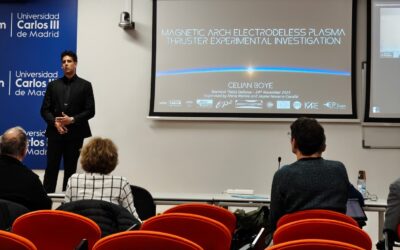We are happy to introduce our third paper for 2025 “Low-frequency oscillations in the magnetic nozzle of a Helicon Plasma Thruster”, published on Plasma Sources Science and Technology.
Abstract:
Oscillations within the plume of a Helicon plasma thruster are experimentally characterized. An array of electrically-floating probes is used to resolve the power spectral density, the coherence, and the wavevector components along both the azimuthal and parallel directions relative to the magnetic field, at various locations and for two mass flow rates. Two main features are identified: a very low-frequency (≃4 kHz), global oscillation mode, attributed to an ionization instability in the source; and a broadband, low-coherence, essentially-azimuthal, ion-acoustic-like spectrum at <200 kHz. Within this range, a mild peak of larger coherence is found at ≃50 kHz, followed by a weak secondary peak at ≃100 kHz at some locations. A bi-coherence analysis discards any nonlinear interaction within the <1 MHz band. However, significant coupling is found between the broadband fluctuations and the Helicon driving frequency of 13.56 MHz, which suggests that the former are likely the result of a parametric decay instability.
Check out the full Open Access paper here. The dataset is also freely availiable on Zenodo.


